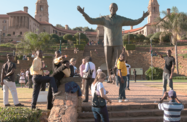Unlike spending on toll roads, new ports, and industrial zones, where the immediate economic needs are easily identified and the longer-term benefits can be reasonably anticipated, gains from investments in sports tourism and related infrastructure tend to be less tangible.
This can be seen in the heated discussions that often precede Olympic bids, and not without reason – as the lengthy debt repayment period for Montreal’s hosting of the 1976 Olympics ably demonstrated, the prestige associated with a major sporting event can have long-term ramifications.
South Africa is no exception, with protracted debates having followed the immense investments and underwhelming returns from the 2010 World Cup. Furthermore, the discussions over the potential for growth in capital-intensive sports tourism in sports-mad South Africa – particularly given the pressing demands elsewhere on public spending and urban planning – have been made all the more urgent by the protracted discussions over logistics for the 2013 Africa Cup of Nations.
According to figures from Brand South Africa, a national branding agency under the aegis of the presidency, roughly 10% of foreign visitors who come to the country each year do so to watch or participate in a sporting event.
SA Tourism, the country’s tourism promotion agency, found that for the year leading up to the R100bn ($12bn) 2010 World Cup tournament, there was a 15% increase in arrivals. In 2011, despite a global slowdown in international travel, the country achieved a further 3.3% increase.
While it is difficult to measure precisely how much of that can be solely attributed to the event itself, according to the results of a survey by the National Department of Tourism (NDT) and South African Tourism (SAT) on the impact of the World Cup, total awareness of South Africa as a leisure destination increased by 9% following the World Cup. More than a third of tourists surveyed associating the football tournament as their first source of awareness of the country.
Furthermore, the tournament has had a number of longer-term benefits for the broader economy. A large proportion of related infrastructure spend, for example, was desperately needed independent of the tournament, and the legacy of the World Cup can be seen in the improved transport infrastructure – such as the high-speed Gautrain linking Johannesburg and Pretoria – and reduced circulation times in major urban corridors.
Given the challenges the country has faced in project delivery with previous public investments – executing only 68% of the allocated budget for infrastructure projects in fiscal year 2010/11 – the fixed deadline imposed by the World Cup, along with heightened international scrutiny, gave much-needed extra impetus to ensure that the required projects were completed on-time.
However, there have been significant concerns over underutilisation of the expensive new facilities in the months following the tournament. New and expanded airports are still operating at less than full capacity, for example, with Durban’s King Shaka International Airport handling less than one-third of the 18m passengers it was built to serve.
Similarly, the spate of new hotels built in advance of the tournament have subsequently struggled to cope with low occupancy levels, which hovered around 50% across the sector for much of 2011.
These issues are likely to come to the fore again in 2013, following the selection of South Africa as a substitute host for the 2013 Africa Cup of Nations (officially known by its French moniker, the Coupe d’Afrique des Nations, or CAN), after the unrest in the original host country of Libya.
With the CAN still a year off, the debate over the benefits of sports tourism has already begun. Local media reported that Cape Town, for example, had wanted a guarantee that SAFA (the South African Football Association) would foot 25% of the hosting costs, with the National Treasury covering a further 50%. Cape Town’s 65,000-seat World Cup stadium, estimated to have cost around $600m, has seen seating capacity reduced to 55,000 to broaden its appeal for smaller events and increase usage.
Johannesburg also expressed reservations about the uncertain costs, and only re-submitted its bid after intervention from the central government. The city’s 90,000 plus capacity FNB Stadium, which was refurbished and expanded prior to the World Cup, is the biggest in Africa, but cost R1.5bn ($182m) to upgrade.
The 2010 World Cup brought immense pride to South Africa and helped provide modest increases in visitor numbers and tourism spending. It left the country with a spate of improved transport corridors, including the Gautrain, and polished the country’s image as an attractive tourism destination. However, the heavy capital expenditures and opportunity costs have mitigated the short-term benefits of the tournament.
In fact, despite being named as the “World’s Leading Sports Tourism Destination” at the 2012 World Travel Awards, having successfully hosted the cricket, rugby and soccer world cups, South Africa’s cabinet announced in May 2011 that it would not pursue an Olympic games bid for 2020, with government spokesman Jimmy Manyi stating that “it is better to consolidate the gains of the 2010 FIFA World Cup for now and rather focus the country's attention on the delivery of basic services to all South Africans”.

